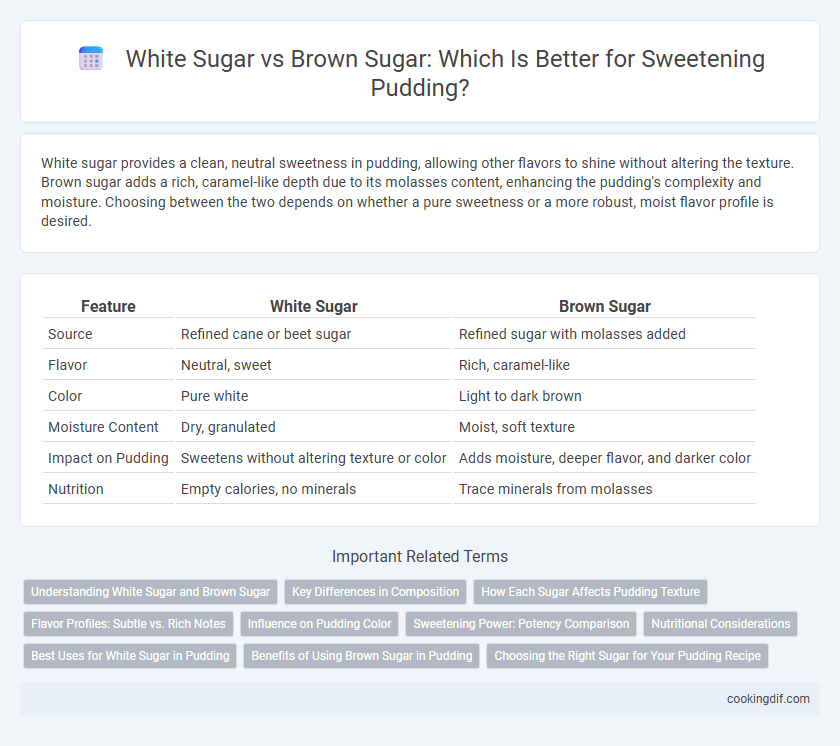White sugar provides a clean, neutral sweetness in pudding, allowing other flavors to shine without altering the texture. Brown sugar adds a rich, caramel-like depth due to its molasses content, enhancing the pudding's complexity and moisture. Choosing between the two depends on whether a pure sweetness or a more robust, moist flavor profile is desired.
Table of Comparison
| Feature | White Sugar | Brown Sugar |
|---|---|---|
| Source | Refined cane or beet sugar | Refined sugar with molasses added |
| Flavor | Neutral, sweet | Rich, caramel-like |
| Color | Pure white | Light to dark brown |
| Moisture Content | Dry, granulated | Moist, soft texture |
| Impact on Pudding | Sweetens without altering texture or color | Adds moisture, deeper flavor, and darker color |
| Nutrition | Empty calories, no minerals | Trace minerals from molasses |
Understanding White Sugar and Brown Sugar
White sugar is refined, consisting primarily of sucrose crystals stripped of molasses, resulting in a pure, sweet flavor and a fine texture ideal for smooth pudding consistency. Brown sugar contains molasses, providing moisture, a richer taste, and a slightly chewy texture that enhances the depth and color of pudding desserts. When sweetening pudding, choosing between white and brown sugar affects not only sweetness but also flavor complexity and final texture.
Key Differences in Composition
White sugar is primarily composed of pure sucrose, refined to remove molasses and impurities, resulting in a finer texture and a clean, sweet flavor ideal for pudding. Brown sugar contains sucrose along with varying amounts of molasses, which imparts moisture, a richer color, and a slightly caramelized taste, affecting the pudding's texture and depth of flavor. The higher moisture content in brown sugar can lead to a softer, denser pudding, whereas white sugar contributes to a lighter consistency.
How Each Sugar Affects Pudding Texture
White sugar dissolves completely in pudding mixtures, resulting in a smoother and more uniform texture, while brown sugar, containing molasses, adds moisture that can make pudding denser and creamier. The molasses in brown sugar also contributes to a slightly caramelized flavor and darker color, which influences both taste and visual appeal. Using white sugar typically yields a lighter pudding with a crisp texture, whereas brown sugar produces a richer, more velvety consistency.
Flavor Profiles: Subtle vs. Rich Notes
White sugar provides a clean, neutral sweetness that allows the pudding's original flavors to shine, making it ideal for delicate recipes. Brown sugar contains molasses, imparting a rich, caramel-like depth that enhances the pudding's complexity and warmth. Choosing between white and brown sugar significantly impacts the overall flavor profile, with white sugar offering subtle sweetness and brown sugar delivering robust, nuanced notes.
Influence on Pudding Color
White sugar maintains the pudding's pale, creamy color due to its lack of molasses, resulting in a visually lighter dessert. Brown sugar contains molasses, which darkens the pudding and imparts a richer, caramelized hue that can alter the final appearance. Choosing between white and brown sugar significantly influences the pudding's color intensity and overall aesthetic appeal.
Sweetening Power: Potency Comparison
White sugar and brown sugar differ in sweetening power due to their composition, with white sugar being nearly 100% sucrose and offering a more potent sweetness per volume. Brown sugar contains molasses, which adds moisture and a slightly lower sucrose content, reducing its sweetness intensity compared to white sugar. When sweetening pudding, using white sugar requires less quantity to achieve the same level of sweetness, while brown sugar imparts a richer flavor but with slightly less sweetness potency.
Nutritional Considerations
White sugar primarily consists of sucrose and contains no vitamins or minerals, offering quick energy but limited nutritional benefits. Brown sugar retains small amounts of molasses, which provides trace minerals like calcium, potassium, and iron, but the quantities are too minimal to significantly impact overall nutrition. Choosing between white and brown sugar for pudding sweetening depends more on flavor preference than nutritional value, as both contribute similarly to caloric intake and blood sugar levels.
Best Uses for White Sugar in Pudding
White sugar dissolves quickly and provides a clean, neutral sweetness that enhances the creamy texture of puddings without altering their color. Its fine granules create a smooth consistency, making it ideal for custard and vanilla-based puddings where clarity of flavor is essential. White sugar also contributes to better caramelization when baking or broiling pudding toppings, producing a golden crust.
Benefits of Using Brown Sugar in Pudding
Brown sugar enhances pudding with its rich molasses content, adding depth and a subtle caramel flavor that white sugar lacks. Its higher moisture level contributes to a creamier texture and helps retain softness over time. Additionally, brown sugar contains trace minerals like calcium, potassium, and iron, providing slight nutritional benefits compared to refined white sugar.
Choosing the Right Sugar for Your Pudding Recipe
Choosing the right sugar for your pudding recipe impacts flavor, texture, and color significantly. White sugar provides a clean, sweet taste and helps create a smooth, creamy texture, while brown sugar adds a rich, caramel-like flavor and a slightly denser consistency due to its molasses content. Understanding these differences allows you to tailor your pudding's sweetness and depth, ensuring the perfect balance for your desired dessert outcome.
White sugar vs brown sugar for sweetening Infographic

 cookingdif.com
cookingdif.com